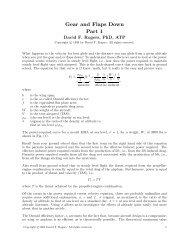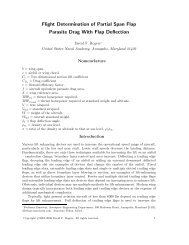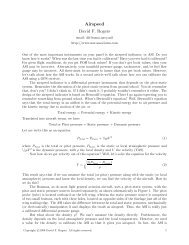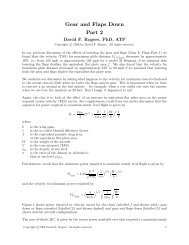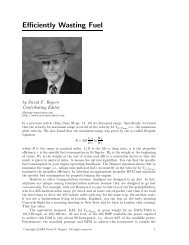Propeller Efficiency Takeoff - NAR Associates
Propeller Efficiency Takeoff - NAR Associates
Propeller Efficiency Takeoff - NAR Associates
Create successful ePaper yourself
Turn your PDF publications into a flip-book with our unique Google optimized e-Paper software.
<strong>Propeller</strong> <strong>Efficiency</strong> – Take Off 2<br />
constant at 285 BHP. The density, ρ, is also constant. As a result, the power coefficient,<br />
Cp, is constant at<br />
Cp = BHP<br />
ρN3 =<br />
D5 (550)(285)<br />
(0.002378)(2700/60) 3 =0.0549<br />
(80/12) 5<br />
where the 550, 60 and 12 are conversion factors and 0.002378 is the density at sea level in<br />
appropriate units. Similarly, the advance ratio, J, is<br />
J = V<br />
ND =<br />
1.69V<br />
(2700/60)(80/12)<br />
1.69<br />
= V =0.00563V VinKTAS<br />
300<br />
The propeller efficiency from 10 to 110 KTAS is shown as the dashed red line on the<br />
bare propeller map in Figure 1. The black × indicates 70 KTAS, which is a typical rotation<br />
velocity for the E33A. The cruise results are also shown for comparison. From Figure 1 we<br />
see that the propeller efficiency during the takeoff run is significantly less than that during<br />
typical cruise conditions, represented by the colored dots. In fact, at 70 KTAS the propeller<br />
efficiency is approximately 0.65 (65%).<br />
Altitude effect<br />
An interesting question is: What is the effect of altitude on propeller efficiency during the<br />
takeoff run? It turns out that there is not much effect of altitude on the power coefficient.<br />
Specifically, the change in brake horsepower is approximately proportional to the change<br />
in density. Thus, the effect of altitude (density) on Cp a quite small. Using the altitude<br />
performance curves for the IO-520BB † the BHP at 10,000ft on a standard day is 200 BHP<br />
Power coefficient, Cp<br />
0.16<br />
0.12<br />
0.08<br />
0.04<br />
0<br />
Blade<br />
angle<br />
29.2 o<br />
25.2 o<br />
TNIO-520<br />
10,000 ft<br />
Take off<br />
20.2 o<br />
NAIO-520<br />
Sea level<br />
Take off<br />
15.2 o<br />
NAIO-520<br />
10,000 ft<br />
Take off<br />
10.2 o<br />
0.3<br />
0.4<br />
0.5<br />
<strong>Propeller</strong> efficiency, η<br />
0.6<br />
+<br />
+<br />
0.7<br />
0.8<br />
0.85<br />
.ο<br />
0.875<br />
0.9<br />
. ..<br />
.ο<br />
0.91<br />
Knee cruise value<br />
Altitude RPM BHP %<br />
6000 ft 2500 75<br />
7500 ft 2300 65<br />
8700 ft 2100 55<br />
14000 ft 2100 45<br />
11000 ft 2100 45<br />
0 0.5 1.0 1.5<br />
Advance ratio, J = V/ND<br />
Figure 1. McCauley C76 propeller map.<br />
†<br />
Teledyne Continental Motors, Aircraft Products Division, “IO-520 Series, Operator’s Manual”, Form No.<br />
X30041, September, 1980.<br />
Copyright c○2010 David F. Rogers. All rights reserved. Published by the American Bonanza Society with permission.



